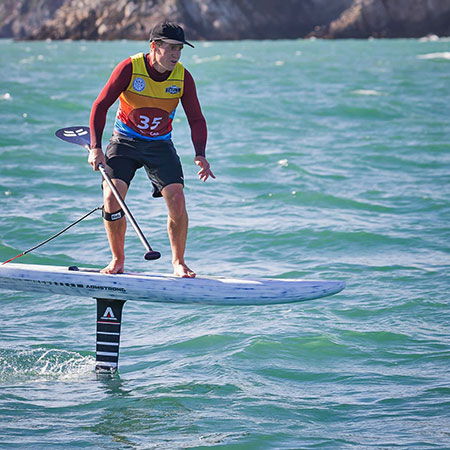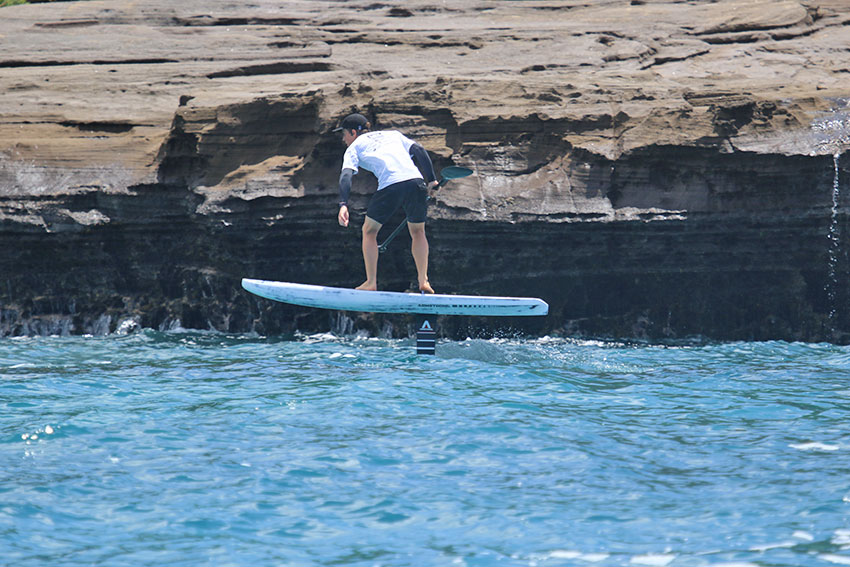Oskar Johansson made a big entry on the international stage with his 2nd place at the Molokai2Oahu 2023. Since then the world has changed for the aussie. He has been traveling the world on foil and is on the forefront of gear development with Team Armstrong.
Its been a while since we had a chat and with the momentum SUP Downwind Foiling is experiencing lately it was time for a catch up.
Aloha Oskar, thanks for taking your time for the Stand Up Magazin. The last time we talked was at the M2O when you arrived on the international Foiling Stage with a bang. Almost winning against James Casey. It was a nail biter but at the end it went James’ way. Regardless, you beat some of the best and pioneers in the sport.
How has your time been since then?
Thanks, it has been a total whirlwind since the M2O. I hadn’t realized how much of the foiling community was following the downwind races, but have been blown away with how much support and froth there is. To be honest, after all the races were done, I just wanted to go and do some turns rather than trying to go mast and straight. Mostly just prone and wing foiling but also back to riding shorter downwind boards and foils that you can surf downwind rather than race.
From what we saw you did some traveling lately including going to France to be part of the French Open SUP Downwind Foiling Championships. Looking at the results and participation it appears that the momentum in Downwind Foiling is not only in Hawaii but Europe as well. How was your experience with the European Community?
France was such an awesome experience. It was a 3 day event where everyone was staying and hanging out together, including the days leading up to the event. It didn’t matter if you were a pro, or just getting into the sport, we were all hanging out and frothing after each day, sharing tips or helping dial in gear. It became just a great community event. It was also mind blowing to see how many people are getting involved in downwind foiling. There are people coming from all over the world in such a variety of conditions and climates, but all just frothing on exploring new runs and pushing the sport. I am not going to lie, the climate of Hawaii is a little more manageable, especially when you forgot your wetsuit like I did, but the food and culture in
France is on a whole new level! You just can’t get sick of a patisserie visit every morning.
Being from Australia having traveled to Hawaii and France. How do you compare these 3 hubs of picking up ocean trend sports rather quick. We have not seen big DW Foiling Comps in Australia have we?

Its really interesting to see how different parts of the world have taken on downwind foiling and their approach. Australia has a strong surf culture, and it feels like we are more concerned with replicating that in our downwind approach. We look at style and favor doing turns. The Hawaiians have a long history of canoe paddling and racing between the islands. You can feel it every time they do a run, they want to go fast and know how to thread a line between the open ocean swells. The French often come from a strong SUP background where they are super fit and strong paddlers, but look for more protected runs rather than the open ocean. I think the event in France really highlighted everyones background but also pushed everyone to explore different and new approaches to down winding.
I think we can agree the biggest commercial and competitive potential in Foiling lies in the DW Racing and Flatwater Pumping. As an athlete you are the forefront of the development of high- performance gear. We are seeing a big push in this direction as far as development goes. Your sponsor Armstrong Foil just released a new generation of Downwind Foils. Can you walk us through the characteristics of the foil and your part in developing it?
There has been such a push lately towards downwind foiling and it’s so exciting to be a part of.
In the past we have been so focused on just getting on foil and not riding the gear that would be suited once we are on foil. With the development of boards going longer and narrower, we are now at the stage where we can develop foils that are fast enough and specifically designed to tap into the open ocean swells down winding. Armstrong has really pushed into this with the new Downwind Performance Foils. They are sitting at an aspect ratio between 13 and 13.55 and optimized to sit at much higher speeds than any of their other foils, and have an incredible amount of glide and efficiency so you can move between bumps without pumping. But they are also developed with a low stall speed that makes it easy to paddle up on foil.
We started testing these about 6 weeks prior to the M2O and have gone through numerous iterations and radical changes. Armie and myself were in Hawaii for the lead up to the M2O and could test and give feed back directly to the designers and make changes prior to the race. Even after the race we made a number of further iterations to refine them to what we have now. For me it was eye opening to see how much detail that goes into developing a wing like this and hear how it all come together.
Foiling is an arms race right now and has been for a while. For you as an athlete at the forefront of it all that of course is a good thing: You get to ride the best and fastest gear and even help developing it.
If you had to break down a DW SUP Foil Race into: Gear, navigational skills and personal fitness. What makes the fastest rider comparing these three ingredients?
Oskar having a great moment at the M2O 2023.
That’s a great question! I think it’s very race dependent. Something like the M2O challenges all of those aspects as well as rider skills and technique. But then a race like in France on the first two days where we raced in enclosed waters, it’s much more of a fitness test.
When racing in the ocean there is a lot more to reading the conditions and finding the fastest line between the bumps. Fitness is also a big part of it, but someone with good ocean knowledge can bridge that gap much quicker than just someone with fitness. You really need to be spending as much time in the ocean as possible!
I can help but posing this question: With all these technicalities and fast development do you think the weekend warrior foiler is getting left behind? What do you tell a new comer who really wants to get into downwind foiling so he / she does not get discouraged?
At the moment I actually think the opposite. The gear has progressed so much that getting on foil and riding downwind is much easier than where it was even just a year to 6 months ago.
I’ve seen people get on foil in their first session DW, where as a year ago it was unheard of to get on foil in your first month. My recommendation would be to buy the latest downwind specific gear, and that’s not just a marketing ploy! The gear has progressed so rapidly that things 6 months old are no where near as easy to get on foil compared to something just released. And lastly, don’t get discouraged! We have all had failed runs, treat it as some good training and exercise if you fail. But the more you fail, the better it feels when you succeed!!
Where do you see foil racing in 5 – 10 years from now?
I see it going much longer, and in wild seas! The thrill and excitement of down winding comes from being in the gnarliest conditions and going fast. As the gear evolves and people get better, we could see us racing 150km plus races in big seas. Potentially even without wind, but just harnessing the open ocean swells. It’s such a rapidly evolving sport and I think we are just at the tip of the iceberg! Can’t wait for the future!
Thank you very much for your time. I am excited for the times to come and look forward to see you at the next M2O or earlier.


